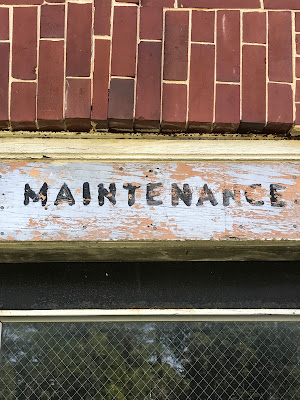He parks the car, exits and immediately heads toward an open area, a large field between 100+ year old buildings. I notice that he is walking at an unusually, for him anyway, brisk pace. He scans the grounds, seeking out any tree that is both visible to his eye and that also has an adjacent, identifying placard. The placards are placed on 3-foot posts and most contain the common and scientific names of the corresponding tree.
Amused, I say, “Silly, stop and observe."
He continues, not unlike a curious child, hop, skipping and jumping, or so it seems to me, from one tree to the next.
“My dear, you are missing the point” I call out through laughter. “At least take a moment or two to observe the tree and not just its name. Look at its shape. Look at its trunk. Look at its seed pods. Look at its leaves. It has a personality, so it's best not to snub it.”
He listens to me for a moment, then defiantly dashes away. Again he reminds me of a child, “I want to find the chestnut trees!”
Okay, fine, go. I lose myself in the timber. I become aware of each tree I pass, from any visible roots to the highest point on its canopy. I stand back to take in the basic shape of the tree. I move in to look at the texture of the trunk, the style of leaves or needles. I discern the flowers, fruit, nuts or seeds it distributes to begin its reproduction process. Then, I look at its name. Sometimes I already know the genus, like oak, but often I do not know the species, such as post oak or bur oak.
I introduce myself.
Within minutes I am drinking and breathing them into my very being, or they are drinking and breathing me into them. I never know which. I forget the rest of the world.
Any ache, hurt or even itch disappears from my physical body. I move fluidly and effortlessly about, like a ghost. I hear what the trees have to say, although no words are spoken.
I spot a tree that has the shape of a woman who has put her arm up to push a lock of hair into place. “Yes, you are beautiful,” I wordlessly tell her. “So lovely that I want to take your photograph, but I oughtn’t.” “Oh do,” she urges.
Some time later I happen upon my male companion. I’d forgotten that we’d even come here together. We've been wandering about the acreage, each in our own world. And now we've stumbled upon each other again. Oh yeah, you. I’d almost forgotten, although we are happy to have reconnected as we realize we have been bounced back to planet earth.
And now, we have somehow managed to accidentally stumble across the three American Chestnut trees and the reason we are here. These true survivors are adjacent to the empty maintenance building. Some being, most likely a human, has pried away the identifying placard and thus a useless 3-foot post stands in front of the triplet trees. Do they not want people to know?
“Are you sure these are American Chestnut trees?” he asks. “Yes, dear, look at the seed pod. Look at the leaves.” He bends to pick up a seed pod that had fallen near his feet, “Ouch!” he says as his bare fingers reflexively let it drop. “Yes,” I chuckle, “That is an American Chestnut seed pod.”
***
like little children they pull me in,
“come, play”
I wander
making new friends
amidst dilapidation I hear,
“look, look”
“look at me!"
“see how I've thrived."
do they miss the youthful energy?
students?
fervent minds?
yes, adaptation
I continue my stroll, finding peace
aware
life prevails
life is precious
More than a century ago, nearly 4 billion American chestnut trees were growing in the eastern U.S. They were among the largest, tallest, and fastest-growing trees. The wood was rot-resistant, straight-grained, and suitable for furniture, fencing, and building. The nuts fed billions of birds and animals. It was almost a perfect tree, that is, until a blight fungus killed it more than a century ago. The chestnut blight has been called the greatest ecological disaster to strike the world’s forests in all of history.
-The American Chestnut Foundation
***
“All living things contain a measure of madness that moves them in strange, sometimes inexplicable ways. This madness can be saving; it is part and parcel of the ability to adapt. Without it, no species would survive.”
-Yann Martel, Life of Pi


















No comments:
Post a Comment